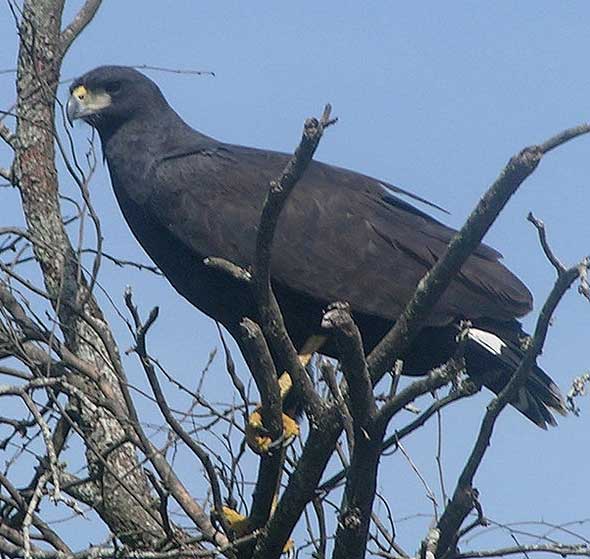
Buteogallus urubitinga(Photo: USGS)
Superregnum: Eukaryota
Cladus: Unikonta
Cladus: Opisthokonta
Cladus: Holozoa
Regnum: Animalia
Subregnum: Eumetazoa
Cladus: Bilateria
Cladus: Nephrozoa
Superphylum: Deuterostomia
Phylum: Chordata
Subphylum: Vertebrata
Infraphylum: Gnathostomata
Megaclassis: Osteichthyes
Cladus: Sarcopterygii
Cladus: Rhipidistia
Cladus: Tetrapodomorpha
Cladus: Eotetrapodiformes
Cladus: Elpistostegalia
Superclassis: Tetrapoda
Cladus: Reptiliomorpha
Cladus: Amniota
Classis: Reptilia
Cladus: Eureptilia
Cladus: Romeriida
Subclassis: Diapsida
Cladus: Sauria
Infraclassis: Archosauromorpha
Cladus: Crurotarsi
Divisio: Archosauria
Cladus: Avemetatarsalia
Cladus: Ornithodira
Subtaxon: Dinosauromorpha
Cladus: Dinosauriformes
Cladus: Dracohors
Cladus: Dinosauria
Ordo: Saurischia
Cladus: Eusaurischia
Subordo: Theropoda
Cladus: Neotheropoda
Cladus: Averostra
Cladus: Tetanurae
Cladus: Avetheropoda
Cladus: Coelurosauria
Cladus: Tyrannoraptora
Cladus: Maniraptoromorpha
Cladus: Maniraptoriformes
Cladus: Maniraptora
Cladus: Pennaraptora
Cladus: Paraves
Cladus: Eumaniraptora
Cladus: Avialae
Infraclassis: Aves
Cladus: Euavialae
Cladus: Avebrevicauda
Cladus: Pygostylia
Cladus: Ornithothoraces
Cladus: Ornithuromorpha
Cladus: Carinatae
Parvclassis: Neornithes
Cohors: Neognathae
Cladus: Neoaves
Ordo: Accipitriformes
Familia: Accipitridae
Subfamilia: Buteoninae
Genus: Buteogallus
Species: Buteogallus urubitinga
Subspecies: B. u. ridgwayi – B. u. urubitinga
Name
Buteogallus urubitinga (Gmelin, 1788: 265) [org. comb. Falco urubitinga]
References
Gmelin, J.F. 1788. Caroli a Linné systema naturae per regna tria naturae, secundum classes, ordines, genera, species, cum characteribus, differentiis, synonymis, locis. Tomus I. Editio decima tertia, aucta, reformata. - pp. i–xii, 1–500. Lipsiae. (Beer). DOI: 10.5962/bhl.title.545 BHL Reference page. [original description: p. 265]
Vernacular names
čeština: Káně velká
English: Great Black Hawk
español: Busardo urubitinga
galego: Gabián negro
日本語: オオクロノスリ
polski: Urubitinga
português: Gavião-preto
The great black hawk (Buteogallus urubitinga) is a bird of prey in the family Accipitridae, which also includes the eagles, hawks, and Old World vultures.
Description
The adult great black hawk is 56 to 64 centimetres (22 to 25 in) long and weighs 1.1 kilograms (2 lb 7 oz). It resembles the common black hawk, but is larger with a different call and tail pattern. It has very broad wings, and is mainly black. The short tail is white with a broad black tip. The bill is black and the legs and cere are yellow.
The sexes are similar, but immature birds are dark brown above with spotting and streaks. Their underparts are buff with dark spots, and the tail has a number of black and dusky bars. The call of great black hawk is a distinctive piping ooo-wheeeeee.
Distribution and habitat
The great black hawk is a resident breeding bird in the tropical New World, from Mexico through Central America to Peru, Tobago and northern Argentina. It is a mainly coastal bird, but also lives in forests and open woodland near water.
Vagrancy
A great black hawk was first recorded in the ABA area on South Padre Island, Texas in April 2018.[3] In August of that year the same individual, based on similarities in what is highly variable immature plumage, resurfaced in Biddeford, Maine.[4] This individual was ranked as the #1 "Craziest Vagrant of 2018" by the ABA.[5]
After disappearing for several months it reappeared in Deering Oaks park in Portland, Maine,[6] where it remained a resident until being rescued during a snow storm on January 20,[7] and transported to the bird rehab facility Avian Haven. The bird was euthanized on January 31 at Avian Haven due to extensive frostbite which prevented blood from reaching either leg or foot.[8] In January 2020 it was mounted and is set to be displayed at the Maine State Museum.[9]
Breeding
It builds a large stick nest in a tree, and usually lays one dark-blotched whitish egg.
Diet
The great black hawk feeds mainly on reptiles, other small vertebrates and large insects, often hunted on foot. This species is often seen soaring above woodlands. Along Amazon rivers it has been observed raiding hoatzin nesting colonies looking for eggs and chicks.
References
BirdLife International (2020). "Buteogallus urubitinga". IUCN Red List of Threatened Species. 2020: e.T22695827A168797108. doi:10.2305/IUCN.UK.2020-3.RLTS.T22695827A168797108.en. Retrieved 12 November 2021.
Gill F, D Donsker & P Rasmussen (Eds). 2020. IOC World Bird List (v10.2). doi : 10.14344/IOC.ML.10.2.
Mendenhall, Matt. "Great Black Hawk spotted on South Padre Island, Texas -". BirdWatching. Retrieved 2019-02-01.
Writer, Deirdre FlemingStaff (2018-08-09). "Birders flock to Biddeford to view hawk that's been seen only once before in the U.S." Press Herald. Retrieved 2019-02-01.
"The TOP 10: Craziest Vagrants of 2018". ABA Blog. 2019-01-31. Retrieved 2019-02-01.
Staff Report (2018-11-29). "Rarely seen hawk appears again, this time at Deering Oaks park in Portland". Press Herald. Retrieved 2019-02-01.
"Avian Haven". www.facebook.com. Retrieved 2019-02-01.
"Avian Haven". www.facebook.com. Retrieved 2019-02-01.
"The Great Black Hawk of Deering Oaks mounted, headed to Maine State Museum". WCSH. Retrieved 2020-03-12.
ffrench, Richard (1991). A Guide to the Birds of Trinidad and Tobago (2nd ed.). Comstock Publishing. ISBN 0-8014-9792-2.
Hilty, Steven L (2003). Birds of Venezuela. London: Christopher Helm. ISBN 0-7136-6418-5.
Retrieved from "http://en.wikipedia.org/"
All text is available under the terms of the GNU Free Documentation License

